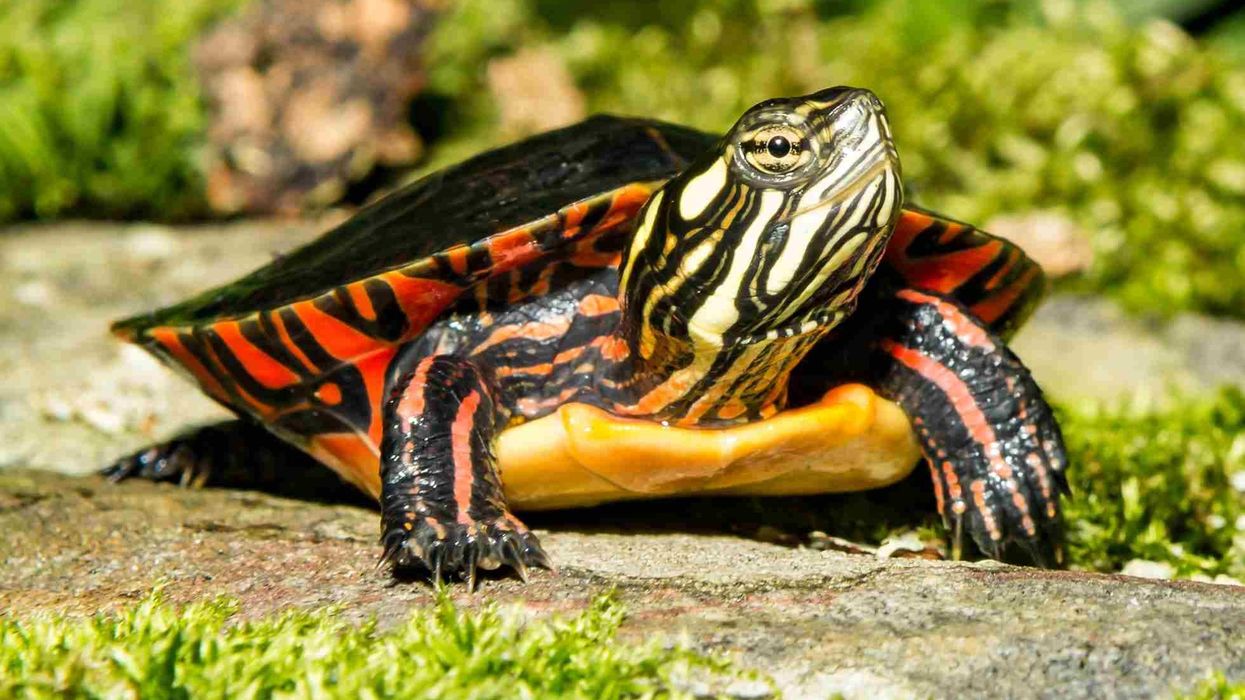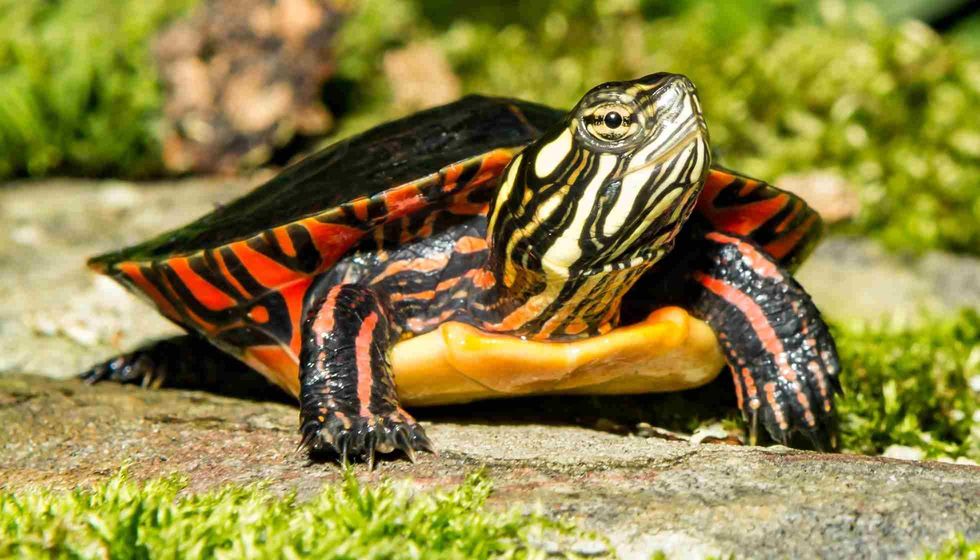The Painted turtles (Chrysemys picta) are extensively popular aboriginal turtles found in North America. These turtles are solely the only species of the genus Chrysemys which is a branch of the pond turtle family called Emydidae.
The Painted turtles have four locally-based subspecies which developed during the last age and these are Eastern painted turtle, Southern painted turtle, Midland painted turtle, and Western painted turtle. The Painted turtles are often confused with red-eared sliders because of their appearance but they differ from them on various aspects.
The Painted turtles can be discovered in freshwater bodies. These Painted turtles are found from Southern Canada to Northern Mexico.
The male turtles are generally smaller than the female turtles. The color of the outer covering of the shell may vary but the texture is smooth without any elevation.
During the winter season, the Painted turtles hibernate at the underside of the water bodies and they prey on other aquatic animals including small insects, fishes, and crustaceans.
The Painted turtles play an integral role in the traditional folklore of the Algonquian tribes also it is the Official State Reptile of Illinois.. From their fossils, it can be deduced that they prevailed 15 million years ago.
To know more details about the Painted turtles keep reading this article. You may also like our articles on the snapping turtle and bog turtle so go and check them out.
Painted Turtle Interesting Facts
What type of animal is a painted turtle?
The Painted turtles are a type of turtle.
What class of animal does a painted turtle belong to?
They belong to the class of reptiles.
How many painted turtles are there in the world?
There are too many of them and it is hard to determine their exact number, but they are very common.
Where does a painted turtle live?
Painted turtles are a very common breed in North America and these turtles in North America are found throughout the continent from Canada to Northern Mexico just like the common Snapping turtles and this describes the Painted turtle habitat.
What is a painted turtle's habitat?
The Painted turtles live in freshwater with smooth bottoms hence they need slow-moving water, with plenty of space to bask, aquatic vegetation to eat in the water and hence they settle in marshes, lakes, ponds, and creeks. however, the habitat is responsible for the evolution of its types.
Who do painted turtles live with?
They are not very social but they are often spotted basking in groups. They are usually solitary creatures.
How long does a painted turtle live?
Painted turtle lifespan is somewhere between 20-30 years but they can live over 50 years as well.
How do they reproduce?
The Painted turtles reproduce by mating during the spring and early summer when the temperature of the water is around 50–77 °F (10–25 °C), which is the beginning of the breeding season.
The males bask in the sun to preserve an internal temperature of 63 °F (17 °C) in the initial spring and the females commence their reproductive cycle in the middle of summer and ovulate during the spring.
The male turtle follows the females until they confront each other and then the male taps the face of the female as a gesture of courtship and the female reciprocate the same gesture and then they copulate at the bottom of the waterbody but the Painted turtle nest is quite far away from the water body where the Painted turtle eggs are protected.
What is their conservation status?
The conservation status is the Least Concern category as reported by the IUCN.
However, they are vulnerable when they are young to some of the Painted turtle predators: Raccoons, red foxes, crows, water scorpions, and plain garter snakes, which are some of their important predators. Their population is deteriorating locally due to various factors including human actions as well as roadkill and territory loss.
Due to environmental changes, the water bodies are drying up, the sites for basking are also getting lost, these kinds of factors are giving more access to their predators and the boost of human footfall.
Painted Turtle Fun Facts
What do painted turtles look like?
The Painted turtle (Chrysemys picta) has a smooth shell, sometimes a dark, oval-shaped shell with overlapping scale-like formation, and the shell are around 12 in (30.5 cm). However, the shells may vary from one subspecies to the other.
The Painted turtle's bottoms are relatively flat and the color of the bottom shell may also differ.
The top shell of this species may range from black to olive color while the bottom shell is often brightly marked with red and yellow color. The Painted turtles also have red and yellow markings on their tail, neck, and legs.
The head of the Painted turtle is extraordinary and its upper jaw is shaped into an inverted philtrum.
The turtle painted with yellow streaks and a large yellow blotch behind each eye and two yellow streaks on the chin are mostly Painted turtles. The females are bigger in magnitude than the males because of their capacity to produce eggs while the males have a longer and thicker tail.
However, the physical manifestation may differ from one species to another, for example, the Midland Painted turtle (Chrysemys picta marginata) has a dark shadow in the center which is symmetrical but, may differ in the pattern.
The Southern Painted turtle (Chrysemys picta dorsalis) has distinguished red streaks and this red Painted turtle has a tan-colored bottom and is almost spotless. The Western Painted turtles (Chrysemys picta bellii) have a large colored spot and the upper shell has web-like designs.
The Eastern Painted turtle (Chrysemys picta picta) has a black or greenish-brown top shell with red markings on the edges while the bottom surface is sometimes lightly spotted but mostly flat yellow.

How cute are they?
They are adorable with their vibrant colors and docile nature especially the albino Painted turtle, but sadly they hardly survive.
How do they communicate?
Vibrations can be considered as a medium of communication among them.
How big is a painted turtle?
A Painted turtle size is 3-10 in (7–25 cm) long, which is half the size of snapping turtles.
How fast can a painted turtle swim?
This species is an aquatic animal and hence they can swim, but the speed at which they do this is not accurately evaluated.
How much does a painted turtle weigh?
As the adult female is bigger than the male. The female Painted turtle weighs around 18 oz (0.5 kg) and the male Painted turtle weighs almost 11 oz (0.3 kg).
What are their male and female names of the species?
Sexual dimorphism in these turtles makes them easy to identify as the males are smaller than the females. However, gender-wise names have not been assigned.
What would you call a baby painted turtle?
The Painted turtle baby which comes out of the oval soft-shelled eggs is called a hatchling.
What do they eat?
Fresh aquatic vegetation, fish, and crustaceans are some of the food Painted turtles eat. A baby Painted turtle diet may consist of tadpoles, insects, and dead fishes as well but as they grow up they start incorporating plants in their diet.
Are they friendly?
They are submissive which makes them friendly towards humans.
Would they make a good pet?
These turtles are very passive and low maintenance which makes them an excellent pet to keep. However, before getting them as a pet you have to keep various things in mind.
For a Painted turtle, care is very important, giving it enough space and sunlight to bask. Painted turtle shell rot is another problem so it is very important to keep their shells clean.
According to a survey, it is found that these turtles are the third most popular pet turtles.. However, the federal law of the United States forbids the sale and transport of any turtle who is below 4 in(10 cm)..
Did you know...
Here is a list of curated facts about Painted turtles:
Painted turtles get their name from their appearance. The pattern on their bodies looks beautifully painted on.
These turtles are some of the only reptiles that can manage to live even after freezing.
The gender of these turtles is not deduced through their genes rather the temperature is responsible for the gender. Cooler climate leads to male offsprings while the warmer climate develops female offsprings.
In the Painted turtles, vocal cords are nonexistent and hence they cannot generate sound.
The Painted turtle shells are composed of 13 bone plates known as scutes and as the turtle grows it sheds the outer layer of its bone plate and grows new scutes. The number of rings present on the scutes can determine the age of the turtle by dividing the number of rings by two..
Teeth are absent in Painted turtles. They can still bite though with their strong jaws.
How much time do painted turtles spend basking in the sun?
Turtles are cold-blooded animals and they need basking to regulate their body temperature. The Painted turtles bask for several hours just like all other turtles irrespective of all ages.
The Painted turtles may bask on a different object but mostly on logs. On numerous occasions, Painted turtles are found basking in groups on logs of sometimes more than 45 turtles spotted basking together.
The Painted turtles emerge from water when the sun rises and eventually after basking for a long period they go back to water. If it finds the need to regulate its body temperature again it shall emerge from the water again except for during the nights.
To be in good health the Painted turtles need to conserve a body temperature between 63–73 °F (17–23 °C). Thus, they bask between six to eight hours a day.
How long do painted turtle hatchlings spend with their mother?
After the breeding season, the Painted turtle hatchlings break from their eggs in August and September, but not all Painted turtle hatchling leaves the nest instantly. After hatching, the Painted turtles sustain themselves on the egg-yolk leftovers.
The Painted turtles grow very fast and after one week or two weeks, the hatchlings start feeding. The mother turtle, after laying eggs, abandons the hatchlings for them to survive on their own. Once done laying her eggs, female Painted turtles retreat.
Here at Kidadl, we have carefully created lots of interesting family-friendly animal facts for everyone to discover! Learn more about some other reptiles including Olive Ridley sea turtle, or green sea turtle.
You can even occupy yourself at home by drawing one on our Painted turtle coloring pages.










